World fishery production, including wild caught and aquaculture, has grown nearly eightfold since the 1950s. Production of wild caught fish has been flat since the late-1980s while aquaculture production has grown about tenfold. Demand for seafood has increased over the last several decades and average consumption outpaced population growth between 1961 and 2016.1
China, including Hong Kong, is the largest producer of seafood contributing 38.7% to total global production in 2017. The United States only produced 3% of global output in the same year.2
In 2018, U.S. commercial fishermen landed 9.4 million metric tons with a value of $5.5 billion according to National Oceanic and Atmospheric Administration (NOAA) Annual Commerical Landings Statistics. Western states, including California, Oregon and
Washington, landed 7.4% of the catch which accounted for 10.8% of value. However, Alaska has the largest fishing industry in the U.S. with 57.6% of the landings and 33.7% of the value. Northeast fisheries are the most valuable. Maine and Massachusetts
only contributed 5.3% of U.S. volume but accounted for 23.6% of the value. Alaska harvested an ex-vessel value of $2 billion in 2018, according to McDowell Group's report on The Economic Value of Alaska's Seafood Industry. Pollock and salmon accounted
for the majority of value. Although pollock is the lowest value fish by pound, it is the most valuable fish in Alaska due to large harvest volumes3 .
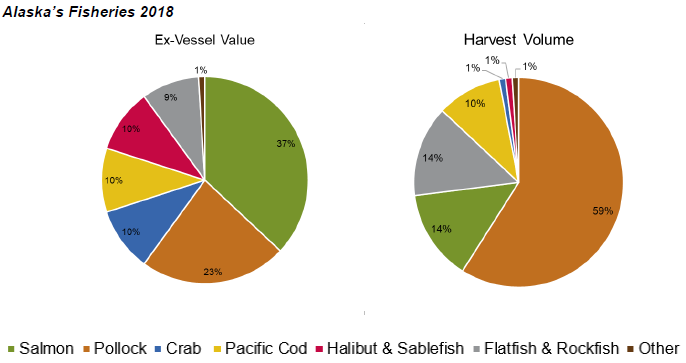
Management Systems
The U.S. commercial fishing industry is a highly
regulated industry. To assure sustainability, access is controlled at both the state and federal levels. Individual states are responsible for managing fisheries - provided their policies are consistent with federal laws - within three miles of their
respective shorelines. Federally managed fisheries are managed by eight regional fishery management councils. The North Pacific Fishery Management Council manages Alaska fisheries and the Pacific Fishery Management Council manages fisheries of Washington,
Oregon and California. These regional councils recommend management plans for each regulated fishery, which are then implemented by the NOAA and National Marine Fisheries Service (NMFS). Regional councils also manage operator permitting, fishing areas
and periods, regulations addressing harvest equipment and requirements for onboard observers.
Management systems include Total Allowable Catch (TAC), license limitations, individual fishing quotas (IFQ) and more. Most fisheries are managed with TAC, which uses scientific surveys to evaluate fisheries' biomass health and are designed to ensure a stable future resource. Approximately 10% of each stock is given to the community development quota (CDQ) groups. Simply put, TAC establishes the supply for each fishery. Therefore, significant TAC reductions limit supply, increase pricing and can lead to increased demand for substitute proteins. To add to the complexity, many species are caught in different fishing areas and TACs are assigned to each fishing area. So, TAC for one area can increase while another one decreases. This can result in price changes that do not reflect TAC changes for every fishing area. IFQs allow individuals holding quota share to participate in fisheries with an IFQ program. IFQs were initially issued to individuals owning or leasing vessels that had fixed-gear commercial landings from 1988 to 1990. Quota shares can be sold or leased, although several provisions exist.
Alaska's fixed-escapement program for salmon successfully manages a sustainable yield. Fixed-escapement is another method that assures fisheries' longevity. Under this program, the salmon fishery is opened and closed daily based on escapement targets4, which affect fishery spawning.
In 1993, NOAA Fisheries instituted a license limitation program for the Pacific Coast commercial groundfish fishery. Federal fishing permits, known as limited-entry permits, control:
- the number of fishing vessels
- the number of vessels using trawl, trap/pot and longline gear types
- vessel length to cap harvest capacity
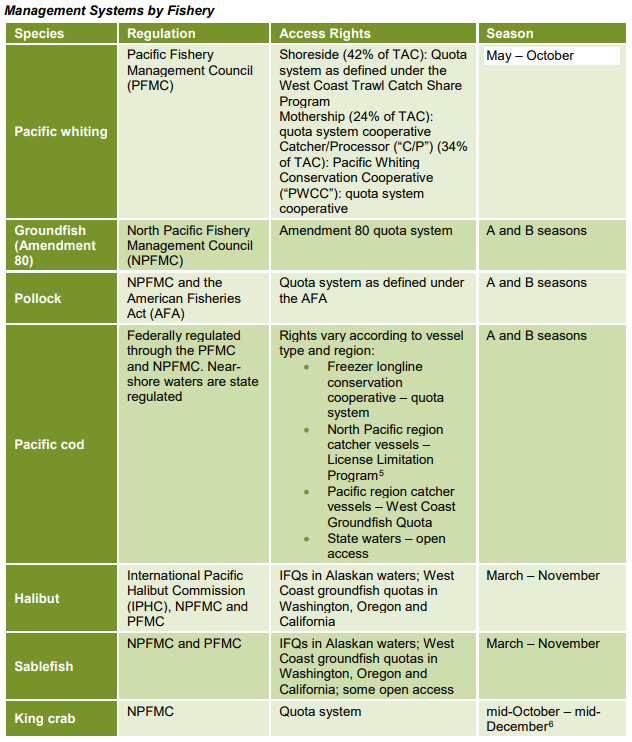

Value Chain
The main fishing-gear types are:
- Trawl net: a funnel-shaped net that is towed or pulled behind the vessel to capture fish swimming either near the ocean floor or in mid-water depths
- Longline: a series of hooks attached to a single line
- Nets: either gill or seine net
- Pots: a wire-mesh pot
Due to the highly perishable nature of seafood, fish is processed or preserved as soon as possible after being harvested. Processing occurs either at sea or at shore-side processors. Processing at sea can occur on board the fishing vessel or the catch
is transported to a mothership7 to be processed. Catch can also be processed at a shore-side facility and can be transported by boats not participating in the fishery, known as tenders, or by the harvesting vessel themselves.
Typically, vessels
that handle large volumes of fish, such as freezer longline cod vessels, process and package the fish on board. These boats clean, cut, package and freeze the fish. Certain vessels in the Amendment 80 and pollock (AFA) sectors catch and process fish
on board as well. Boats participating in the pollock fishery that don't have on-board processing capabilities deliver the catch to a mothership or to a shore-side processor.
Smaller, higher-value fisheries, such as salmon, will be bled and refrigerated on board the vessel and the cutting and packaging is left for the shore-side processor. Crab is delivered to the processor alive.
Shore-side processors can filet, clean, can or prepare the whole fish for shipment. Processors continue to develop
new products such as fish meal and fish oil to increase use of the entire fish and capture more value.


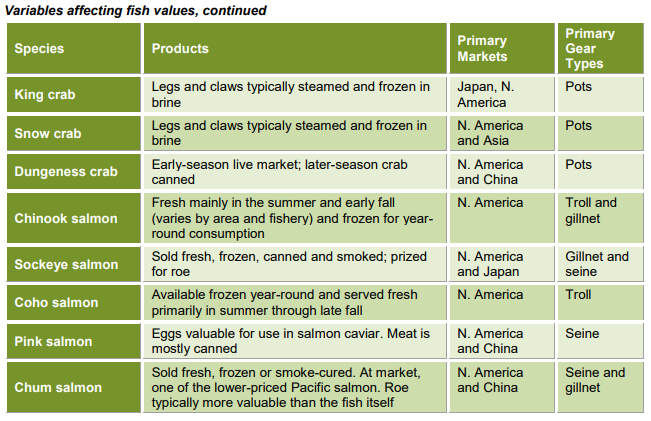
Drivers
Resource Availability
Since the late-1980s, wild-capture fishery production has remained relatively static. However,
per-capita consumption of seafood has risen. Much of the growth in production has come from aquaculture or farmed fish8.
Maintaining the availability, or health, of each fishery's biomass in the long run influences global supplies of wild-caught
fish. Resource availability is calculated and controlled through various programs. NOAA is the federal agency responsible for managing fisheries in U.S. federal waters. NOAA scientists work with regulatory fishery management councils to monitor fish
populations and ensure sustainability. They report long-term average harvest levels that balance fishing with fisheries stock rebuilding. The percentages of stocks subject to overfishing are falling.
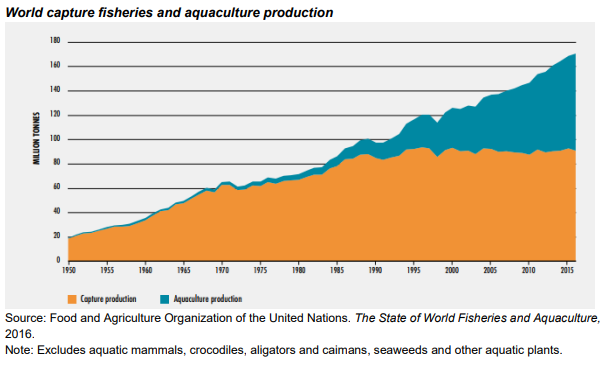
When biomass health is compromised and the TAC reduced, a fishing operation's net income can be negatively impacted if the market price is not enough to
offset the decline in production volume. However, fisheries management is imperative for long-term access to the resource and health of the biomass.
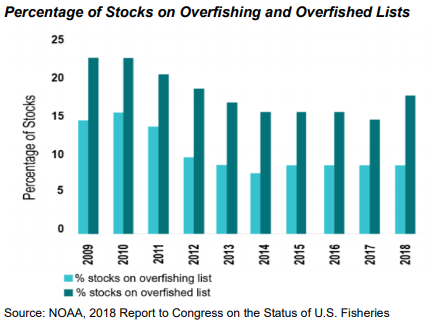
Bycatch
NOAA rules regarding bycatch9 also impact fishing practices and available supply. Examples include species-selective fishing gear, education
and outreach, standardized reporting and fisheries closure.
There are strategies for limiting bycatch such as capital investment in equipment revisions. However, these strategies can increase fuel costs and slow operations. Although bycatch restrictions
increase the fishery's harvest costs, they help sustainability of other fisheries.
Weather Events
Weather events, such as El Nino events, which raise water temperatures in the Pacific Ocean, can affect fisheries. Although no definitive conclusions
explain the failure of the Prince William Sound salmon run in 2016, consensus points to ocean conditions, including warmer water and algae growth impacting the health of the salmon biomass while at sea. Another example includes domoic acid outbreaks10 that typically occur because of warm water. These outbreaks have delayed several fisheries including the Dungeness crab fishery on the West Coast.
Global Markets
Export markets are critical to U.S. seafood industry profits. Estimates suggest
60-70% of Alaska's seafood is sold in export markets. The largest importers of seafood from Alaska's commercial fisheries include China, Japan, the European Union and South Korea.
Russia is increasing investments in its fleets to stimulate growth
in its fisheries industry. U.S. seafood will experience significant competition from Russia, especially in pollock, cod and crab.
Biomass declines and pollution have encouraged the Chinese government to implement regulation to protect marine
resources. Much of this regulation will result in significant supply shortages, causing China to look elsewhere for its seafood. However, in 2018 a trade war erupted between the U.S. and China. Seafood has been impacted by Chinese tariffs making U.S.
product more expensive in China.
Modernization
The average age of a vessel in the North Pacific fleet is 40 years. Modernizing a vessel can increase fuel efficiency, update processing ability and capacity, and attract and retain high-quality
crew members. However, the capital needed to modernize a large fishing vessel is costly --between $15 million and $130 million depending on the type of vessel11. Generating the kind of profit needed to support this investment is difficult
for many fisheries12.
Several vessels have been updated or constructed since 2000; most have been completed for Amendment 80 or freezer longline vessels in federally managed fisheries. The industry expects modernization to continue,
presenting both opportunities and challenges.
Appendix A
Best Practices
Financial Management
- Sound and demonstrated industry expertise and excellent peer performance
- Audited quality financial statements
- Quality of internal accounting appropriate for the size of the business, requiring little to no adjustment
- An ownership/management transition plan exists (and is funded); the next generation is adequately prepared; a clear exit strategy is in place
- Thorough knowledge of cost structure, profitability and market dynamics
- Earnings regularly retained in the business, evidenced by recurring liquidity improvement and/or reinvestment in income-earning capital assets; owner distributions are not excessive or detrimental to the company's financial position
- Growth is part of the long-term business strategy; forward-looking mindset reflected in quality projections
- Operation has no reliance on processor advances
Production Management
- Top-quartile peer performance for production
- Diversified among multiple fisheries
- Established quota-lease relationships help maximize profitability
- Superior vessel or fleet and performance compared to peers
- Clearly defined fishing plan and vessel maintenance plan in place
- Most efficient and modern technology incorporated in fishing operation
- Aligned with high-quality, reputable processor(s)
Processing Management: Shoreside
- Processing facilities strategically located near fishing grounds/fleet, with strong ability to also source raw materials from outside locations
- Value-added processing facilities with ongoing state-of-the-art upgrades to lines
- Capacity-ready facilities (with minimal delivery limits)
- Capacity-ready facilities (with minimal delivery limits)
- Processing facilities adaptable to more than one fishery
- Full use of processing facility assets
- Strong and active fleet management group that maintains loyalty among producers
- Active and participatory role in fishery management, following best sustainability and stewardship practices
- Robust food safety/quality control programs strictly adhered to and certified by their customer base or third party
- Consistent ability to staff up with seasonal labor
Processing Management: Catcher-Processor
- Consistent production combined with efficient use of onboard processing equipment, which maximizes recovery and includes value-added, at-sea processing
- Owns or has access to sufficient quota to maximize production and processing capabilities of the vessel
- Catcher-processor platform incorporates the newest technology and maintained to high standards
- Processing platform adaptable to more than one fishery
- Strong ability to attract and retain efficient, reliable crew members
Marketing Management
- Well-recognized brand with strong reputation at the consumer and distribution level
- Diversified market channels for commodity and consumer-ready products (10+ key accounts); for catcher-processors, may be aligned with a large, well-known processor/marketer
- Many product line offerings with diversification in species and level of value-add
- Strategically located distribution facilities with ease of access to multiple markets
Appendix B
Glossary
Biomass: 1) The total weight of a group (or stock) of living organisms (e.g. fish, plankton) or of some defined fraction of it (e.g., spawners) in an area, at a particular time. 2) Measure of the quantity,
usually by weight in pounds or metric tons, of stock at a given time.
Bycatch: Fish and other marine creatures accidently caught during fishing for a specific, targeted species.
Chinook salmon: Also known as king salmon. In North America, Chinook salmon range from Monterey Bay in California to the Chukchi Sea area of Alaska. Along the Pacific coast of Asia, they are found from the Anadyr River of Siberia southward to Hokkaido, Japan. Chinook are the largest of the Pacific salmon, weighing up to 130 pounds and measuring nearly five feet long; however, their typical weight and length are about 30 pounds and three feet. Chinook are "anadromous" which indicates that they hatch in freshwater streams and rivers, and then, after approximately one year, they reach the smolt stage and migrate to the ocean. They remain there until they reach three or four years old, at which time they return to spawn in the fresh water where they hatched.
Chum salmon: Also known as keta salmon or dog salmon. The most widely distributed of all Pacific salmon, chum live in waters as far north as the McKenzie River on the Arctic coast of Canada and throughout the west coast of North America. On the Asian side of the Pacific, chum salmon are found from Korea and Japan to northern Russia. They can grow over three and a half feet long and tip the scales at 30 to 35 pounds; however, the average chum weighs 8 to 15 pounds.
Coho salmon: Also known as silver salmon. Found throughout the north Pacific Ocean and in the surrounding coastal streams and rivers from Alaska to central California and from Russia to Japan. In North America, they are most abundant in coastal areas from southeast Alaska to central Oregon. Wild coho are harvested commercially on both sides of the Pacific, but Alaskan fisheries supply most of the global market. Coho are also farmed in floating pens offshore in Chile, Japan and Canada. Coho salmon are smaller than chinook and larger than sockeye; market-sized coho average 4 to 12 pounds. Hatchery-raised fish often are smaller at two to three pounds each.
Community Development Quota (CDQ): The Western Alaska Community Development Quota (CDQ) Program allocates a percentage of all Bering Sea and Aleutian Islands quotas for groundfish, prohibited species, halibut and crab to eligible communities.
Drift gillnet: Gillnet boats have large spools with a net wrapped around them called net reels. The two different types of gillnet vessels are distinguished by placement of the net reel. With sternpickers, the net is situated on the ship's aft; with bowpickers, the net reel is on the bow. Some vessels have the design versatility to set the net off either the bow or stern. Typically, gillnets are set in a straight line, like a curtain. These nets feature a cork line that floats atop the water and a lead line that pulls the bottom of the net downward in the water. Nets are subject to IV specific mesh diameter requirements for each fishery so as to catch the targeted fish while simultaneously limiting bycatch volume. The harvesting mechanism is simple; fish swim into the net and are caught by their gills. Most gillnet vessels range in size from 27 to 32 feet.
Gillnet setnet: One end of a gillnet is anchored on the beach or in shallow water. Attached on the net's opposite end is a large buoy. A small skiff - usually 18 to 25 feet long - is used to pull the unattached end out to deeper water where it remains suspended by the buoy.
Groundfish: Fish that live on, in or near the bottom of the body of water they inhabit. Some typical saltwater groundfish species are cod, flounder, halibut and sole.
Dungeness crab: Also known as red or red stripe. Dungeness crabs inhabit bays and estuaries. This crab species is found as far north as the Aleutian Islands and as far south as Mexico's Magdalena Bay. It has a broad, oval body covered by a hard shell, four pairs of walking legs and a pair of claws. The legs of Dungeness crab are much smaller than king crab's, and its body is more oval than the snow crab's. Only male Dungeness crab can be kept during harvest, provided they meet or exceed the fisheries' allowed size, which is usually specified at six and a half inches wide.
Ex-vessel price: The price received by a captain at the point of landing.
Federally managed fisheries: Any fishery located in the U.S. Exclusive Economic Zone (EEZ) from three miles offshore to 200 miles offshore.
Halibut: Halibut and black cod are the fourth most valuable fishery in Alaska, making up 11% of all fisheries' ex-vessel value in 2014-15. Pacific halibut is one of the largest flatfish; it weighs up to 500 pounds and can grow to more than eight feet in length. Pacific halibut live in coastal waters from Santa Barbara, California to Nome, Alaska, and the western side of the Pacific, from the Gulf of Anadyr in Russia to Hokkaido, Japan. However, they are most common in the central Gulf of Alaska. Adult halibut migrate seasonally from shallow summer feeding grounds to deeper winter spawning grounds.
Individual Fishing Quota: Permits to harvest specific quantities of fish or shellfish.
Jig fishing: A hook-and-line method that uses an electric jig machine that pulls a lured line up and down in the water. Each jigging machine can handle as many as five lines at a time and each line can have as many as 30 hooks attached.
King crab: Also known as Bristol Bay red king crab. The largest of the commercially harvested crabs, red king crabs are found in the Bering Sea, Aleutian Islands and along the Gulf of Alaska's coast, south of British Columbia, Canada. Populations also range from Hokkaido, Japan to Cape Olyutorsk, Russia. In terms of appearance, king crabs are brownish to bluish-red in color and are covered with sharp spines. Only male crabs can be kept during harvest. Similar species include golden (brown) king crab and blue king crab.
Landings: The point at which fish are brought to shore.
Longline: Longline gear consists of a long series of hooks attached by a leader to a single line. The most common longlines are used for harvesting cod, halibut and sablefish, and are the
most efficient
type of gear for selective bottom fishing. The gear is set using anchors and buoys, and retrieved using an automated line-hauler with a person standing at the rail ready to retrieve targeted species and to release prohibited or undesired bycatch.
Overfishing: Harvest rates higher than maximum sustainable yields.
Oysters, mussels and clams: Shellfish grown throughout the Pacific Northwest. Shellfish growers are treated similarly to traditional farming operations, rather than as a commercial fishing enterprise.
Pacific cod: Also known as cod, grey cod, true cod or P. cod. In 2014-15, Pacific cod was the fifth-largest fishery by ex-vessel value and cod was the seventh most valued U.S. domestic species in 201513. Pacific cod are located in the coastal north Pacific Ocean, from the Bering Sea to Southern California and westward to the Sea of Japan. They live on the shelf edge and upper slope in waters ranging from 300 to over 800 feet deep during the winter and move to waters shallower than 300 feet deep during the summer.
Pacific whiting: Also known as hake and whiting. A species similar to pollock. Whiting is caught in federal waters off the coasts of Washington and Oregon.
Pollock: Also known as walleye pollock and Pacific pollock. The United States' largest fishery by volume, and the second largest fishery worldwide. With annual landings valued at nearly $500 million, the pollock fishery makes up 26% of Alaska's ex-vessel value. Although pollock is distributed throughout the North Pacific, the largest concentrations are found in the eastern Bering Sea.
Pink salmon: Also known as humpback salmon or humpies. Found on both sides of the North Pacific from Alaska to Puget Sound in Washington and from Russia to North Korea. Though their range extends further south, pink salmon do not reproduce in significant numbers below Puget Sound. Typically weighing between three and a half and five pounds and growing to an average length of 20 to 25 inches, pink salmon are the smallest and most abundant of the Pacific salmon species found in North America. Today, they account for almost half the salmon harvested in Alaska's fisheries where their populations are well managed and stable. In Washington, pink salmon are harvested in smaller numbers during odd-numbered years in concert with the species' lifecycle.
Pot gear: Pots are constructed by stretching wire-mesh netting around a cylindrical or rectangular frame that is left open on at least one side. Bait is strung within the pot to attract the fish inside the trap. This design allows the targeted species to enter and not escape and also limits bycatch.
Regional councils: The Magnuson-Stevens Fishery Conservation and Management Act (MSA) created eight regional fishery management councils responsible for the fisheries that require conservation and management in their region. The councils are composed of both voting and 13 All values sourced from NMFS, ADF&G (compiled by McDowell Group) and NOAA's Fisheries of the United States, 2015. Non-voting members representing the commercial and recreational fishing sectors in addition to environmental, academic and government interests. Under the MSA, councils are required to:
- Develop and amend Fishery Management Plans
- Convene committees and advisory panels and conduct public meetings
- Develop research priorities in conjunction with a Scientific and Statistical Committee
- Select fishery management options
- Set annual catch limits based on best available science
- Develop and implement rebuilding plans
Sablefish: Also known as black cod and butterfish. Found across the Northeastern Pacific Ocean from the Gulf of Alaska to northern Mexico, and west to the Aleutian Islands and beyond into the Bering Sea. Adult sablefish live on mud bottoms in waters more than 650 feet deep.
Seine gear: Seine boats are 40 to 58 feet in length14. The seine is a large net with a cork line that floats and a line weighted with lead at its bottom. When the net is cast, the lead line sinks to the bottom, allowing the unfurled net to hang in the water like a curtain. One end of the seine is pulled by a skiff that encircles the targeted species. After the set is made, a rope threaded through the weighted bottom of the net - known as the "purse line" - is pulled closed. When the fish are trapped inside the net, it is hoisted by winch onto the deck of the purse seine vessel.
Snow crab: Also known as opilio crab and opies. Snow crab are widely distributed in many oceans. In Asia, they're found in the Sea of Japan and the Sea of Okhotsk. In the Atlantic, they're found from Southwest Greenland to Maine. In Alaska, they live in the Bering, Beaufort and Chukchi seas, but are harvested only in the Bering Sea. Their preferred habitat is soft sandy or muddy bottoms, typically in water shallower than 650 feet.
Sockeye salmon: Also known as red salmon. Sockeye salmon are found on both the eastern and western extremes of the North Pacific. In North America, sockeye salmon range from Point Hope in northwestern Alaska to the Klamath River in Oregon. In Asia, they're found from Siberia's Anadyr River area southward to Hokkaido, Japan. In the United States, almost 100% of the sockeye salmon comes from domestic fisheries that operate primarily in Alaska. Measuring 1 to 2 feet in length and weighing 4 to 15 pounds, sockeye are among the smaller species of Pacific salmon.
Stocks overfished: Low stocks compromising maximum sustainable yields.
Stock rebuilding: Also known as the maximum sustainable yield.
Total Allowable Catch (TAC): An annual catch ceiling. All catch taken in directed fisheries or caught incidentally in other fisheries, whether retained or discarded, is counted in the TAC. Management plans prescribe that TAC may equal, but never
exceed, the Acceptable Biological Catch (ABC), and always must be less than the Overfishing Limit (OFL). Fisheries are managed in-season to achieve the TAC without exceeding the ABC or OFL. The sum of TACs for all
14 To participate in a fishery
in Alaska state waters, a boat cannot exceed 58 feet. VII groundfish stocks also must remain within the optimum yield range as defined in the Fisheries Management Program. All the TAC numbers can't add up to more than two million. The
ABC and OFL are determined for the respective fishery using statistical information gathered from stock survey results. The TAC is set by the respective management council based on these recommendations.
Trawlers: A trawl net is a funnel-shaped bag that is towed behind the vessel to scoop up fish swimming either near the ocean floor or in mid-water depths. The narrow end of the trawl net is called the "cod end." When the net is full or the tow complete, the cod end is brought aboard by winch so that the fish can be unloaded. Attached toward the open end of the net are large steel plates called "trawl doors." These are used to weigh down the net and maintain the desired depth.
Troll fishing: Troll vessels typically feature tall poles from which gear is rigged. A series of baited hooks hang from these poles. When a fish is hooked the line is pulled in either by hand or by a motorized revolving drum, or spool, called a "gurdy."
Tenders: Usually contracted by a processor, a
tender vessel is used to receive fish from smaller catcher vessels underway at sea and then transport those fish to the contracting processor.
Appendix C
Additional Information
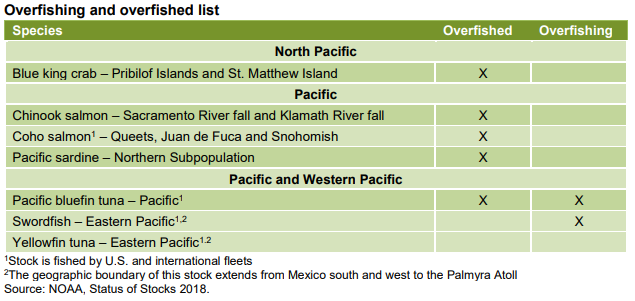
Alaska Department of Fish and Game: http://www.adfg.alaska.gov/index.cfm?adfg=home.main
International Pacific Halibut Commission: http://www.iphc.int/
NOAA Fisheries: https://alaskafisheries.noaa.gov/fisheries/commercial
Washington Department of Fish & Wildlife: http://wdfw.wa.gov/
List of terms and acronyms: http://www.westcoast.fisheries.noaa.gov/publications/col_basin_partnership/6.7.2016_acronymlist_noaa_fisheries.pdf
______________________________________________________________________
1 Food and Agriculture Organization (FAO), The State of World Fisheries and Aquaculture 2018. 2 FAO, Global Aquaculture Production online query 3 McDowell Group, The Economic Value of Alaska's Seafood Industry, September 2017.
4 Adult spawning salmon escaping capture and spawning in rivers
9 Fish caught while fishing for a different species
10 Domoic acid can be deadly to humans when a certain amount is consumed, therefore fisheries must be delayed when domoic acid is present.
11 Bristol Bay salmon boats and combination longliners and seiners fall well below the $25 million level.
12 McDowell Group. Modernization of the North Pacific Fishing Fleet, November 2016.
Stay up to date
Receive email notifications about Northwest and global and agricultural and economic perspectives, trends, programs, events, webinars and articles.
Subscribe